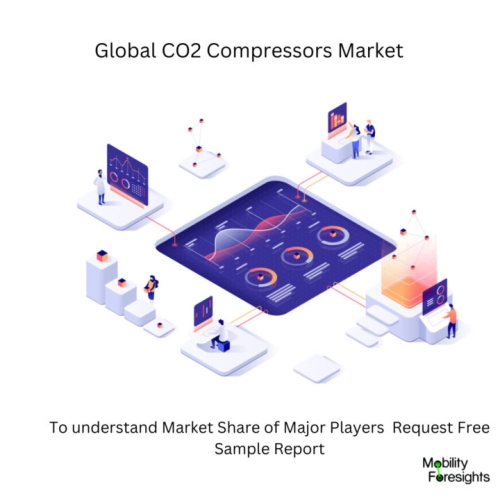
- Get in Touch with Us

Last Updated: Apr 25, 2025 | Study Period: 2023-2030
A CO2 compressor is a device that uses a mechanical process to increase the pressure of carbon dioxide gas. The gas is compressed from a low pressure to a high pressure, which can be used for a variety of applications.
CO2 compressors are used in a variety of industries, including:Food and beverage: CO2 is used to carbonate beverages, such as soda and beer.Manufacturing: CO2 is used to clean and degrease parts, and to create foams and plastics.
Healthcare: CO2 is used to freeze tissue and organs, and to create medical gasses.Research: CO2 is used in a variety of research applications, such as studying the effects of climate change.
There are two main types of CO2 compressors: reciprocating compressors and screw compressors. Reciprocating compressors use pistons to compress the gas, while screw compressors use two helical rotors to compress the gas.
CO2 compressors can be either single-stage or multi-stage. Single-stage compressors compress the gas in one step, while multi-stage compressors compress the gas in multiple steps. Multi-stage compressors are more efficient than single-stage compressors, but they are also more expensive.
CO2 compressors can be either oil-free or oil-lubricated. Oil-free compressors do not use any oil, which makes them cleaner and safer to use. However, oil-free compressors are less efficient than oil-lubricated compressors.
CO2 compressors can be either stationary or portable. Stationary compressors are designed to be installed in one location, while portable compressors are designed to be moved from one location to another. Portable compressors are more expensive than stationary compressors, but they are also more versatile.
When choosing a CO2 compressor, it is important to consider the following factors:The required pressure: The pressure of the CO2 gas that is required.The required flow rate: The amount of CO2 gas that is required.
The type of application: The type of application that the CO2 compressor will be used for.The budget: The amount of money that is available to purchase the CO2 compressor.
CO2 compressors are a valuable tool that can be used in a variety of applications. When choosing a CO2 compressor, it is important to consider the factors that are most important for the specific application.

The Global CO2 Compressors Market accounted for $XX Billion in 2022 and is anticipated to reach $XX Billion by 2030, registering a CAGR of XX% from 2023 to 2030.
Emerson, a firm based in the United States, has announced the invention of the refrigeration industry's first transcritical CO2 screw compressor, which is built "for the rigors of high-pressure industrial CO2 refrigeration."
The new Vilter-branded transcritical CO2 compressor, which will be released later this year, will complement the existing Vilter subcritical CO2 compressor.
Both compressors will be shown at exhibit #411 at the International Institute of Ammonia Refrigeration (IIAR) 2023 Natural Refrigeration Expo in Long Beach, California, from March 12 to 15.
To date, CO2 refrigeration technologies have been based on commercial-grade, multi-compressor techniques, which have proven to be unnecessarily complicated. The new CO2 portfolio is meant to respond to the industry's desire for industrial-grade CO2 refrigeration solutions.
Building on tradition of invention, we created the industry's first transcritical CO2 screw compressor, designed for heavy-duty industrial applications and rated for CO2 transcritical pressures.
The new Vilter transcritical CO2 compressor is based on established single-screw compression technology and includes an on-board controller, suction valve/strainer, inverter duty motor, and an oil management system.
Furthermore, the transcritical CO2 compressor is designed for maximum flexibility, with the ability to scale from single-, dual-, and tri-compressor configurations based on capacity requirements, all while using the same oil management system and controller.
The novel transcritical CO2 compressor is built and rated to resist the high pressures of CO2 in transcritical mode and is intended for the high stage of a CO2 transcritical system. It will be made available.
It will be offered in seven displacements, with power ranging from 100 to 800 horsepower per compressor, up to 1,600 horsepower in dual configuration and 2,400 horsepower in tri-configuration.
The subcritical CO2 compressor is intended for the low side of CO2 transcritical or cascade systems and comes in 11 displacements with power ratings ranging from 100 to 800HP per compressor.
| Sl no | Topic |
| 1 | Market Segmentation |
| 2 | Scope of the report |
| 3 | Abbreviations |
| 4 | Research Methodology |
| 5 | Executive Summary |
| 6 | Introduction |
| 7 | Insights from Industry stakeholders |
| 8 | Cost breakdown of Product by sub-components and average profit margin |
| 9 | Disruptive innovation in the Industry |
| 10 | Technology trends in the Industry |
| 11 | Consumer trends in the industry |
| 12 | Recent Production Milestones |
| 13 | Component Manufacturing in US, EU and China |
| 14 | COVID-19 impact on overall market |
| 15 | COVID-19 impact on Production of components |
| 16 | COVID-19 impact on Point of sale |
| 17 | Market Segmentation, Dynamics and Forecast by Geography, 2023-2030 |
| 18 | Market Segmentation, Dynamics and Forecast by Product Type, 2023-2030 |
| 19 | Market Segmentation, Dynamics and Forecast by Application, 2023-2030 |
| 20 | Market Segmentation, Dynamics and Forecast by End use, 2023-2030 |
| 21 | Product installation rate by OEM, 2023 |
| 22 | Incline/Decline in Average B-2-B selling price in past 5 years |
| 23 | Competition from substitute products |
| 24 | Gross margin and average profitability of suppliers |
| 25 | New product development in past 12 months |
| 26 | M&A in past 12 months |
| 27 | Growth strategy of leading players |
| 28 | Market share of vendors, 2023 |
| 29 | Company Profiles |
| 30 | Unmet needs and opportunity for new suppliers |
| 31 | Conclusion |
| 32 | Appendix |